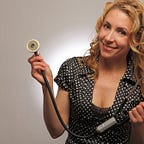DIY Healthcare With 3D Printing: Personalized, Inexpensive and Groundbreaking
An important current trend is the Maker Movement. When applied to healthcare, patients can hack their illnesses with simple modifications. Patients are making a difference by driving solutions in their own care, on an individual case-by-case basis.
The Maker Movement has begun to intersect with healthcare in long-reaching, meaningful ways. It has become a fundamental part of the vision at the U.S. Department of Health and Human Services (HHS). TechShop has made a point to provide access and tools for healthcare Makers. MIT has joined the fray with MIT Hacking Medicine, an ecosystem for entrepreneurs to hack medicine. The idea is patients innovating to help themselves, and to make discoveries that can help countless others.
A cornerstone of the Maker Movement is 3D printing, also called additive manufacturing, one of the most disruptive technologies across every industry and economy. Its applications in healthcare are tremendous and game-changing. Widespread access to and knowledge about 3D printing is going to take the patient maker movement to a whole new level.
The biggest concept behind 3D printing is: Complexity is Free. What does that mean? That it will cost the exact same amount of money to print a 3D medical device or brace for me that’s perfectly fitted to my body as it does to print out a perfectly fitted brace for anyone else’s body. It doesn’t cost more money to make something more intricate and complex, beyond the “ink.”
The explosive growth of 3D printing means that you can personalize and individualize literally every single thing in your life to your exact specifications — color, design, size. This is a huge difference from making one-size-fits-all. Anything that goes on or in the body will be printed to fit you 100 percent. Just about anything that was previously made of plastic or metal can now easily be printed in 3D.
An example of 3D printing’s potential are external wearable devices like casts and braces that will be made by 3D printers using plastic, which can be exposed to water. Old-styles casts are clunky and uncomfortable — they’re itchy and they’re bulky and don’t fit comfortably under clothing. You can’t get them wet, and after a while they become ragged-looking and smelly. A 3D cast is thinner and lighter than a traditional cast. It is waterproof and has holes in it to make it easier to wash and scratch the skin underneath. Finally, a cast you can shower with! It could be made with colors and personalized designs so it would be more fun to wear. The best part is, a personalized 3D cast won’t cost any more — and might even cost less — than a traditional cast. The cost to add in some personalized design is basically zero — and in terms of design and innovation, you’re only limited by your imagination.
3D printing would be able to furnish hospital with on-demand supplies and equipment. In areas with unstable supply lines or in remote locations, 3D printing will mean the difference between being able to access some supplies, or having nothing at all. For example, Dr. Loubani in Gaza recently 3D-printed a stethoscope that cost $2.50 to make, instead of paying the $200 price tag for a traditional stethoscope. He has data to prove that the printed stethoscope works as well as a traditional one. It’s difficult to get enough medical supplies to places like Gaza and 3D printing provided an immediate solution, with accurate results.
Widespread access to and knowledge about 3D printing is going to take the patient Maker Movement to a whole new level. I expect to see rapid progress, now that patients suddenly have easy access to new tools to create solutions that can make a major impact, especially in daily routines.
Traditional medicine isn’t deeply personalized, but the Maker Movement is making it possible for patients to individualize their treatments, share their work and ideas in communities, collaborate together and innovate further.
